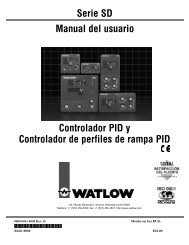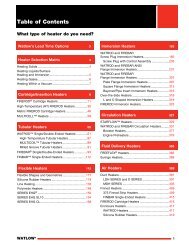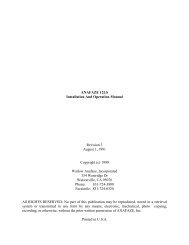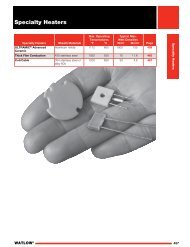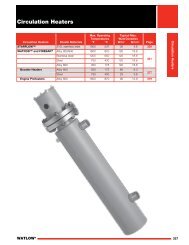RADIANT HEATING WITH INFRARED - Watlow
RADIANT HEATING WITH INFRARED - Watlow
RADIANT HEATING WITH INFRARED - Watlow
You also want an ePaper? Increase the reach of your titles
YUMPU automatically turns print PDFs into web optimized ePapers that Google loves.
Radiated Power vs. Wavelength (Fig. 5)<br />
W/in 2 µ<br />
W/in 2<br />
Blackbody<br />
Real Surface<br />
Gray Body Approximation<br />
Wavelength (microns)<br />
From the curves, it can be seen that a heater radiates energy over a broad<br />
spectrum of wavelengths.<br />
It can also be seen that as the heater temperature (Th) increases:<br />
• The energy radiated increases (as Th 4 ).<br />
• The “peak” energy wavelength gets shorter (the curve moves to the left).<br />
• For a given heater, more energy is radiated at all wavelengths.<br />
• A higher percentage of the energy is distributed in a narrower wave band.<br />
The peak energy wavelength for a given heater temperature can be<br />
calculated using Wien’s displacement law:<br />
Peak Energy Wavelength (microns) = 5269 microns °R<br />
Temp. (°F) + 460<br />
For example, if a heater is operating at 1000°F:<br />
Peak Wavelength = 5269 microns °R<br />
1460°R<br />
Peak Wavelength = 3.6 microns<br />
This corresponds well to Planck’s curves for a 1000°F heater. Many materials<br />
do not absorb all wavelengths of radiation equally. For example, plastics<br />
typically have “wavelength bands” in the infrared region that are well<br />
absorbed, and the balance of the energy is transmitted. For some<br />
applications, such as heating thin films of plastic or water, it may be beneficial<br />
to select a heater that operates in a temperature range that results in peak<br />
energy wavelengths that are well absorbed by the material. If heating a<br />
product that absorbs well around 3.6 microns, then, in theory, a 1000°F to<br />
1400°F heater will result in the highest percentage of energy absorption.<br />
5




